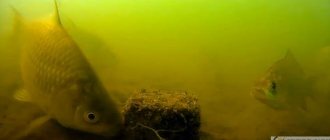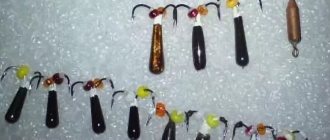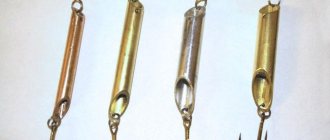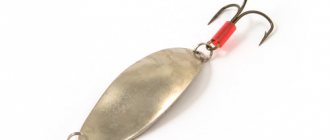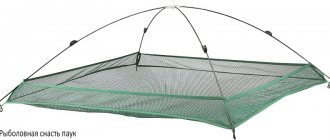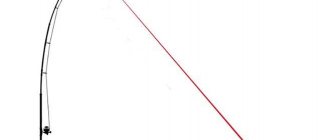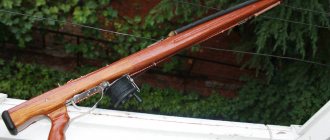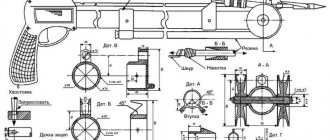What is a shock leader, why is it needed in a feeder
The shock leader on the feeder is a piece of fishing line with a higher degree of strength, capable of withstanding serious shock loads than the main thread. It is its thickness and proper installation that prevent the fish from escaping.
The active use of the leader is observed not only in feeder fishing, but also in the spinning and carp fishing methods.
This equipment element is used to:
- preserve the tackle in case of idle casting and when it is difficult to lower the line from the reel;
- prevent the line from breaking when inserting the trophy into the landing net;
- prevent damage to the braided line when fishing in areas with a rocky bottom and an abundance of sharp shells;
- protect your fingers from being cut by thin fishing line when casting.
Types of shock leaders
There are three types of leaders, each of them has advantages and disadvantages.
According to the material, it comes from:
- small diameter braids;
- thick monofilament;
- fluorocarbon line.
There is a leader on sale made from conical fishing line, which has an increased degree of strength and a low level of elongation. You can combine the main line and shock leader in the following design:
- monofilament and braided cord;
- braided cord and thick monofilament;
- wicker and wicker of larger diameter;
- monofilament and thicker monofilament.
When choosing a shock leader, consider not only the distance from the shore to a promising point, but also the weight of the equipment and the nature of the bottom of the reservoir.
For what purposes should an angler use a braided shock leader?
The leader shock is a special insert made of a more durable material, the length of which is, as a rule, two times the length of the feeder rod. There are significantly fewer scenarios for such fishing than for monofilament fishing line, however, there are situations when it is the braided line that shows maximum efficiency:
- Catching wary fish at long range. No matter how good the fishing line is used by the fisherman, its stretchability negatively affects the sensitivity to bite, which is why careful touches by the fish to the bait may simply be unnoticeable. A shock leader made of braided cord in such a situation helps out the fisherman, with the help of which confident work with the tackle is ensured without compromising sensitivity;
- River fishing. A situation where a fisherman is forced to work with heavy feeders on a thin braided cord, which is fraught with regular shooting. The use of an insert made of braided cord with a diameter of about 0.17-0.2 millimeters can solve all problems and feel confident while working with gear;
- We should not forget about the emotional component. Whatever one may say, the braided cord itself gives much more emotions during fishing. Try catching a large bream on the same fishing trip using a tackle with a line shock leader, and then replace it with a braided line and compare the sensations. You will be surprised!
Mounting shock leader
To achieve harmony when assembling the equipment, it is necessary to eliminate the formation of additional friction on the guide rings when using this element of the equipment. Otherwise, the casting distance of the tackle will be reduced. The unit used must be durable and easy to manufacture.
Length
The optimal length of a shock leader is two rod lengths with a margin of 2–3 m. If you plan to fish with a rod 3.9 m long, then to make a shock you will need 10–11 m, and maybe 12 m of fishing line. This will allow you to use the cut leader with equipment on your next fishing trip.

Usually this element of equipment is done before entering the reservoir, at home. The knot must be tied neatly and pass freely through the guide rings of the rod. To calculate the length, it is enough to multiply the distance from the reel to the tip of the whip by two. Ideally, the shock takes the distance to the reel plus 5 turns on the spool.
Fishing line or braid
It is easy to select a braided cord according to the manufacturer's instructions on the packaging. You can also use a spinning line with a round cross-section to make a shock. For beginners, it will be easier and more convenient to work with monofilament.
Among the positive characteristics of braided cord are:
- increased degree of sensitivity;
- low extensibility;
- compactness of the unit;
- stealth in water;
- fishing in hard-to-reach places (thickets of reeds, grass).
Among the disadvantages of braided wire it is worth highlighting:
- high cost;
- possibility of cutting your fingers;
- the need for frequent cleaning of debris (in strong currents);
- low strength relative to monofilament.
Monofilament fishing line is actively used to strengthen gear. The main thing is that the thread has a homogeneous structure with a moderate degree of rigidity. To obtain a reliable knot, the elasticity of the fishing line plays an important role. When purchasing, you should pay attention to the absence of roughness on the surface of the fishing thread; when unraveling, it should not curl like a spring.
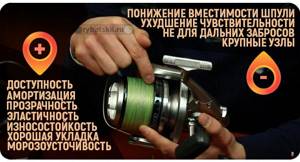
The advantages of monofilament include:
- sufficient transparency;
- resistance to low temperatures;
- good stretch/strength;
- excellent cushioning when playing a trophy;
- low risk of injury;
- good placement on the reel;
- availability.
Of the minuses, you need to know that monofilament:
- forms large nodes;
- reduces bobbin capacity if the thread is thick;
- impairs the susceptibility of equipment;
- not suitable for ultra-serious casting.
Unlike thick monofilament, braid with a minimum diameter does not form large knots, has a sufficient margin of strength and easily fits into small rod rings. If fishing will take place in areas with a rocky bottom, then use a fluorocarbon option to protect the main line. It is characterized by increased resistance to mechanical stress.
Knots with a minimum volume are obtained with a conical type of fishing line. It is presented for sale already in the form of a ready-made shock 10–15 m long. This thread differs in different diameters, on one edge it is 0.3-0.4 mm, and on the other – 0.6-0.8 mm.
The thin section of the fishing line for the shock leader can withstand a load of up to 10 kg, and the opposite section - up to 30 kg. If you need to increase your casting distance, then a tapered line is the ideal solution. Among the disadvantages, they note the high cost of the product and the impossibility of using it like snow, the installation of which is carried out in the same way as a shock leader.

It is necessary to trim the conical line from the side with a larger diameter, so the leader will not lose its functionality.
Knot
There are different knots for tying a shock leader, but the most popular is the “carrot”. The unit is simple to implement and highly efficient. Before you start tying, make sure that there is no damage, bends, or abrasions on the edge of the main thread caused by previous fishing.
If there are any, cut them off. Such a check is also required for the thread that will be used for shock.
For greater fishing efficiency, change the leader before entering the water again. If hunting is carried out in difficult conditions, then it is recommended to replace this element of equipment 2-3 times per fishing trip. You can not change it only if you are fishing in an area with a soft muddy bottom, but provided that there is no obvious damage.
"Bloody Knot"
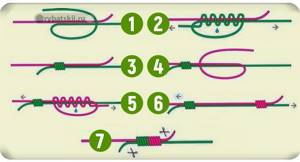
The manufacturing technology is as follows:
- Place one fishing line overlapping the other, the length of the free ends is 15–20 cm.
- At the intersection point, press the threads with your fingers, wrap one around the other, making 5 turns.
- Return the edge of the fishing line to the intersection and form a loop.
- Wrap the second thread around the first, also making 5 turns.
- Pull the free edge of the second thread into the loop and make a knot.
- Trim off excess part.
- Glue the knot.
It is good to use this version of the knot when tying threads with a difference in diameter of 1/3. Its strength indicator is 87%, the ligament is barely noticeable.
"Carrot"
The sequence of actions is as follows:
- Stepping back 4-5 cm from the edge of the braided cord, tie a regular knot, but there is no need to tighten it too much.
- Thread monofilament into the resulting loop with a margin of up to 30 cm.
- Make a shock winding with the leader of the main thread, at least 10 times in one direction, then hold it with your fingers, and the same amount in the other. The result will be a kind of braid.
- Insert the main material into the loop and tighten the braided knot.
- Moisten the twist and tighten, holding the two ends.
- Remove excess material.
- Treat the bundle with glue.
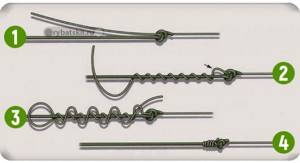
Thanks to its 100% strength, the carrot knot is considered the most reliable. It can be used when using different materials. The twist comes out cone-shaped and neat; there are no difficulties with passing through the pass rings.
Albright
The algorithm for performing the manipulations is as follows:
- Make a loop of thick thread 10 cm long. No need to tighten.
- Thread a thin vein into the loop with a margin of 20 cm.
- Fix the threads at the point of their intersection with your fingers and make 10 turns around the loop with a thin vein in the opposite direction.
- Pass a thin vein through the loop and tighten.
- Trim off the excess portion of the two materials.
- Apply glue to the knot.

The Albright unit is distinguished by its small size and ability to withstand heavy loads. It does not create difficulties when casting gear. This helps deliver equipment over long distances quite easily.
Main types of nodes
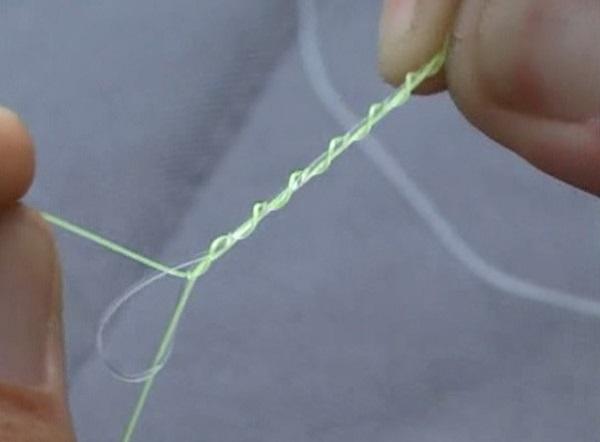
Basic fishing knots for splicing the shock leader with the main thread:
- Improved Albright Knot - improved (modernized) Albright knot;
- Mahin Leader Knot – classic carrot;
- Double Grinner Knot – double Grinner (sliding).
Each angler has his own favorite method of tying knots, but it is advisable to master and apply all of the listed options, since each has advantages and certain performance characteristics.
Improved Albright Knot
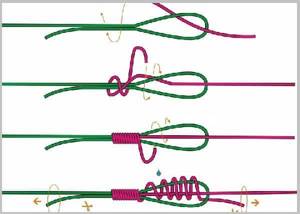
The modernized Albright is the best knot for splicing the shock leader with the main thread. It turns out narrow, passes well through the rings, and almost does not reduce the accuracy and casting distance. At the same time, strength and durability do not decrease.
Step-by-step knitting instructions:
- Bend the end of the main line to make a loop.
- In the other hand we take the tip of the shock leader and thread it through the loop.
- We make 7-8 turns around the main thread.
- We turn the end of the leash in the opposite direction and put it into the loop again.
- All that remains is to smoothly tighten the line.
Now you need to trim off the extra tails. The Improved Albright Knot is ready.
Mahin Leader Knot (Carrot)
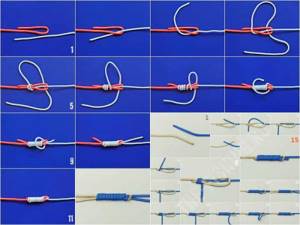
The knot is complex, but when implemented correctly it turns out to be strong, narrow, its tips point away from the rings, so the cast turns out to be long, since nothing interferes with its execution. Suitable for different types of fishing line, especially multifilament line with fluorocarbon.
For reference: “Carrot” was originally invented by carp anglers, but is often used by spinners and match fishing enthusiasts.
The fisherman's knot "Carrot" is knitted in several stages:
- At the end of the shock leader we make a double loop and insert the free tip into it.
- We insert the main line into the resulting loop.
- Now, holding the loop with one hand, we begin to wrap the main line around the leash.
- Having made 8–10 revolutions, we intercept our structure with the other hand and make 8–10 revolutions in the opposite direction, trying to overlap the lower turns with the same pitch.
- We thread the free end of the fishing line through the loop again.
- We wet the thread and smoothly assemble the knot. First we tighten the loop, then we begin to carefully lay out the turns. You should get a narrow, even knot, without bumps or overlaps.
Recommended reading: Catching asp with castmaster
Trim off the excess ends. Mahin Leader Knot is ready.
Double Grinner Knot

Double Grinner is used for splicing monofilament fishing line and braided cord. It turns out to be thicker than Albright and Carrot, so it is not very suitable for ultra-long distances. However, its high strength allows you to confidently catch large carp at an average distance.
Instructions for knitting Double Grinner Knot:
- We put the main core and the shock leader together.
- We make a loop from the shock leader and wrap it 5–7 times around the folded lines.
- We tighten the turns, getting the floor of the knot.
- Now we make the same 5-7 turns, but with the main fishing line around the folded threads.
- We tighten it.
- We take the line and the shock leader in two hands, and smoothly pull them in different directions.
Trim off the excess ends of the thread. The double Grinner knot is ready.
When a shock leader is not needed
There are situations when you do not need to tie the shock leader to the feeder, among them are:
- I fish at a slight distance from the coastal zone, when there is no high probability of the equipment coming off during the casting process.
- When fishing is carried out with the main fishing line, and not with a braided cord. The fishing line already copes with the resistance of the prey when fishing. It is easier to cast over long distances if you use a line as a base. The leader will be relevant if it is mounted directly to the cord. Feeders are excellent for catching large, capricious individuals over long distances.
- Fishing using inexpensive rods with low-quality whips that are damaged. Otherwise, free passage of the unit through the passage rings will be impossible, which will result in cargo breakage. If the rods are of good quality, there will be no difficulties with shock.
- During a geometric cast like a catapult with a large overhang of the load. Acceleration of the load here occurs smoothly, there is no hard shooting with a finger. To deliver the equipment as far as possible, increase the length of the fishing tool.
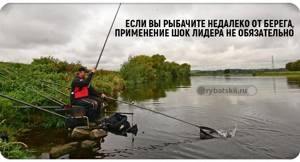
By equipping a shock leader with a feeder, the angler manages to use thin materials in the main line. This reduces the degree of its resistance in water. High-quality material and correct installation ensure increased efficiency of the gear.
Types of knots and methods of tying them
Using a shock leader raises a logical question: how to properly attach a shock leader. The task is complicated by the fact that the assembly for the shock leader must not only be durable, but also compact, otherwise there is a danger of it getting stuck in the guide rings. This is especially important for a feeder, the passage rings at the top of which have an extremely small diameter.
In order to connect the shock leader with the main fishing line, anglers usually use the following knots:
Read more
How and what to catch trout with?
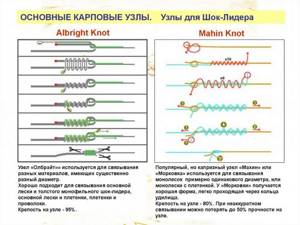
The main component of the shock is the connection with the main cord
- carrot knot for shock leader;
- boom assembly for shock leader;
- bloody knot.
A separate problem is created by the question of how to tie the shock leader to the braid. Most knots are not suitable for this task, as braid can cut the line. The maximum strength of the connection is ensured by the carrot knot.
It must be remembered that before tightening the knot, it must be wetted. This will reduce friction and protect the line at the knot from damage. To ensure that the knot passes through the guide rings better and does not come undone accidentally, it can be glued with super glue.


